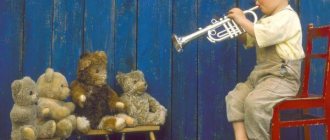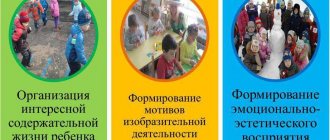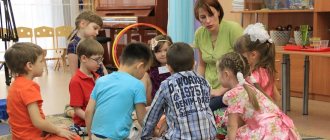Features of the work of a preschooler: how, why and why?
In preschool education, one of the main things is the organization and training in work activity and teaching many of its methods available to children in groups of this age. There has long been an expression among people that labor turned an ordinary animal (monkey) into a highly developed intelligent being (human). And, no matter how exaggerated these words sound, there is some truth in them.
In the process of organizing labor activity, organized and expedient, the child receives the necessary knowledge and skills, but this is not even the main benefit. Through the necessary actions performed by the body, the brain also develops, or rather, even the basic mental functions: thinking, perception, will. That is why labor education of preschool children is a very important and serious area.
The main areas of work activity of preschoolers
For a kindergarten teacher, task number one is to help children get acquainted with the world of adults. Children must learn to perform simple actions themselves: wash their hands and face, sweep the floor, do laundry. Parents do not always realize that the basis of all their child’s skills are labor skills that form independence, determination, and diligence. These qualities will then help the child quickly and easily find his place in society.
The main goal of labor education of children in kindergarten, according to the Federal State Educational Standard, is to develop in them a positive attitude towards work. This can be achieved only by taking into account the age characteristics of the pupils. The type and complexity of the activity in which they are planned to be involved depends on the age of the children.
What goals does the teacher pursue in teaching preschoolers:
- awaken in children a desire to help adults, instill in them a positive attitude towards work;
- desire to deepen and improve work skills;
- achieve a strong habit of employment, responsibility, careful attitude towards one’s own and other people’s products of labor;
- lay the foundations of the ability to organize your work;
- teach children a friendly attitude towards the activities of others, the ability, if necessary, to make tactful comments, and evaluate the results of their activities and the work of a friend.
In accordance with the Federal State Educational Standard, labor activities of preschoolers occur in the following areas:
- mastering self-care skills, which is important for any age group;
- skills in everyday life and housekeeping, work in nature are also characteristic of both the younger group and the preparatory group;
- manual labor is present in the senior and preparatory groups.
?
Work on developing labor skills should be closely related to creativity. To discover the talents of a creative person, seeing joy in work is a necessary condition.
At what age does work begin?
So, since this article is focused exclusively on the preschool age, it is important to define it right away. The final stage is quite obvious: this is the period from 6.5 to 7 years, when the child goes to school. Conventionally, in psychology, the upper limit is considered to be 7 years, but for some the transition to school time (junior schoolchildren) occurs a little earlier, for others a little later. It all depends on a purely formal moment: entering first grade and starting school.
It is much more difficult to determine the lower limit. When can a child’s activity be called work, and can we begin to teach him to perform conscious actions without fear that he will harm himself? In psychology, it is believed that this age begins at 3 years old. Here, too, it should be understood that this is only formal: it is different for different children.
Some are already ready at 2.5, while others are just starting to succeed at 3.5. And yet, at about 3 years old, the child moves from object-manipulative activities (when he touched and felt objects, not always understanding their real purpose) to role-playing games. He develops a social interest and begins to learn how to build relationships and connections. Then it is advisable to begin full-fledged labor education, and the forms can be completely different.
Labor education in relation to different age groups
Preschool age is the best time to develop basic self-care skills, certain skills, and observation. With each stage, the load becomes more complex and requires appropriate actions from the guys. Adults need to remember about age-related characteristics, show patience and kindness, so as not to cause denial in the child.
- The child's fingers are not yet sufficiently developed and do not obey him well.
- The sequence of actions is also not given to the baby; it is difficult to remember everything the first time.
- A younger preschooler will not be able to attract volitional efforts to help; these abilities are still just being formed.
Teachers usually know which teaching methods are appropriate for each age group. They have the responsibility to give recommendations to parents so that children develop harmoniously.
Taking into account the physiological and psychological characteristics of pupils, you need to remember that for children 3-4 years old, the optimal duration of work is 10-15 minutes . Children aged 6-7 years do physical exercise for a maximum of half an hour. The condition of each baby must be monitored. Pay attention to sweating and redness of the skin, when they appear it is better to change your occupation. To prevent children from getting tired, it is better to move on to other activities after 10-15 minutes. When dosing them, be sure to take into account the volume of physical activity and its complexity.
Card index of games for artistic and aesthetic development
Labor education in the younger group
Children 3-4 years old are active, often talking about their desire to participate in one activity or another. But they get tired quickly, it is difficult for them to concentrate, so you should not overload them. The assignments of adults in the younger group are more individual in nature; the student will only need to hang up towels or arrange the cutlery for dinner.
Points to consider:
- labor education is situational in nature, for a three-year-old the main thing is that the tasks are simple and understandable;
- children should be praised for any success;
- In order for the child to understand the meaning of his actions, the teacher needs to explain the tasks and evaluate the results;
- Before doing anything, the child needs to observe how an adult copes with it; then the child’s actions follow with step-by-step comments from the teacher.
The main method of working on labor education with children 3-4 years old is personal example. The guys watch the actions of their elders, manual labor, various exercises are carried out in a playful way. Knowledge is consolidated through the example of such famous works as “Fedorino’s grief” or “Moidodyr”.
Labor education in the middle group
By the age of four, the baby will be able to handle sweeping paths or washing doll clothes. The tasks gradually become more complex, and the children already have some self-organization skills. They can be entrusted with duty in the dining room or preparing for classes; the children are quite capable of performing simple care for animals in a corner of nature.
In the working method it is important:
- note the child’s desire to help;
- the work is carried out in a playful way (application and design, rules of behavior in various situations are reinforced through role-playing games);
- visual aids are used;
- Conversations are held about the content of future actions and relationships.
Labor education in the senior group
Collective assignments are already being used with children aged 5-7 years. When interacting with each other, children learn to coordinate efforts, agree on something, and share responsibilities among themselves. Playing for children is still the main activity, but they meet the teacher halfway, help replace bed linen in the bedroom or collect leaves on the site.
It is important for the teacher to organize the workspace and equipment. Shovels and watering cans should be bright and comfortable to make children want to play with them. Elegant aprons will create a feeling of celebration. The duration of classes should not be overtiring.
?
The main goal of the labor development process in preschool educational institutions is to develop a respectful attitude towards the activities of adults, familiarity with the main professions, understanding of their significance, and the desire to help.
Labor education in the preparatory group
For older preschoolers, work takes on a systematic nature and becomes more numerous. Children repair books or boxes and sew buttons on their own. Under the supervision of the teacher, they prepare the necessary manuals for classes, counting material, and cut out specified elements from plastic bottles. The guys themselves notice the disorder in the area, water the flowers, and remove fallen leaves.
Drawing lessons in the senior group on the topic “Indoor plants”
In the seventh year of life, pupils help set the table for dinner, the attendants monitor the availability of soap and towels, the quality of hand washing, and look after the living area.
How does the work of young children differ from adult work?
So, we have resolved the issue of age; now it is necessary to consider what exactly can and should be considered the work of a child. Naturally, it has significant differences with similar activities of an adult. And the main thing is that child labor is largely a voluntary activity, has entertaining forms and is not too extended over time.
Moreover, it has virtually no social significance. That is, everything done by a child and presented as the result of his labor is valuable exclusively for him alone and his peers. True, parents and other relatives can also admire and praise. This is the main feature of the work activity of preschoolers.
We can also add to them that in order to achieve the goal, work must be organized and controlled by adults, clearly explained and shown by example. Children are quite small, and they will not yet be able to achieve the desired result themselves.
Therefore, everything is done only with the guidance of mentors, with clear organization, and has content that is relevant to the child. In other words, he understands and is interested.
Labor education of preschool children. The uniqueness of the work of preschool children
Labor education of preschool children.
In preschool childhood, the process of familiarization with the values of society begins. Labor is one of these universal human values.
Hard work and the ability to work are not given by nature, but can be cultivated from early childhood.
At preschool age, the foundations of labor education are laid.
This has also been proven in scientific research .
In 1953, studies were carried out by Z. N. Borisova - on the role of duty in kindergarten and by V. G. Nechaeva - on labor activity in preschool age. They laid the foundation for a large group of scientific works devoted to labor education.
In the 60-80s. XX century An in-depth study of the work activity of preschool children is being carried out (R. S. Bure, V. I. Loginova, M. V. Krulekht).
A massive study of the problem of labor education of preschool children gave a positive result:
¨ opportunities for preschoolers to get involved in work
¨ features of work of preschoolers
¨ content of work for each age group of kindergarten
¨ features of the methodology for labor education.
¨ The influence of work on the moral development of a child was also studied.
Research proves that preschool age is a sensitive period for the formation of a positive attitude towards the world of objects and the work of adults in the immediate environment.
Let's consider the concept of "WORK"
Labor has always been the basis for human life and culture
Human labor creates all the material and spiritual values necessary for a person to satisfy his various life needs; In the process of labor, the person himself improves, his personality is formed.
Labor is a type of human activity aimed at creating spiritual and material values.
Labor activity can be directed
· for creation
(creating something new)
· for transformation
(change of existing one).
This applies to both material and spiritual values,
Let's define it using specific examples
: what is the direction of work activity and what is the product - material or spiritual values:
Ø sewing clothes
Ø composing music
Ø washing dishes
Ø text translation
Ø raising children continue this list
Labor as an activity has certain structural elements
(they are highlighted in their works by A.N. Leontiev, S.L. Rubinstein)
ü goal (necessarily motivated)
ü material (creation)
or
subject of labor (transformation)
ü tools and equipment
ü labor actions
ü result
Preschoolers, under the guidance of teachers, will be able to identify these components in the work of adults
and focus on them
in organizing your own work.
Of course, we will not offer children adult terms goal - what we plan to make a material or object of labor - what we will make tools and equipment from - what is needed for work labor actions - how we will do everything in order result - what happened
Filling out the table for 2 types of labor
: making boxes and washing plants.
Mastering these components of labor and the ability to perform accessible labor actions occurs in the process of labor education.
Labor education
is a pedagogical process aimed at instilling in children a positive attitude towards work, knowledge about work activity, and the formation of labor skills.
Labor education in kindergarten is aimed at developing the psychological and practical readiness of a preschooler for work.
Labor education can be successful due to the characteristics of preschool children:
imitation, curiosity, desire for active activity.
The result of labor education is labor education.
Labor education
–
level of formation of labor activity, level of mastery of the position of the subject of labor activity:
level of knowledge about labor activity
level of development of labor skills
level of attitude towards work
The originality of the work of preschool children.
1
.
The work of people in society is always aimed at creating material and spiritual values. The work of children does not and cannot have such significance. The results of children's work satisfy the needs of the child himself or those around him .
The main difference between child labor is the absence of a result that has material significance for society.
2.
The importance of children’s work lies in its educational impact on the child’s personality.
Work in preschool age is an effective means of versatile, and above all moral, education.
Such moral and volitional qualities as perseverance, perseverance, responsibility, conscientiousness, mutual assistance, skill are formed.
What exactly can be considered a child’s work?
And yet, what exactly should be understood by the concept we are describing? Labor refers to any purposeful human activity, conscious and meaningful. It is necessary in order to modify or adapt surrounding objects and thereby satisfy needs.
Simply put, we work to make our own lives easier and create something new and necessary. This, by the way, also includes artistic work, because as a result, a certain material work is created, aimed at satisfying the primordial human need for the beauty of the objective world around it.
Absolutely any work activity has its own components, certain forms and content. And even in different age groups these characteristics do not change.
Characteristics of preschool children's work activity
Well, let's start with the fact that any child labor needs clear organization on the part of an adult. In addition, it requires content that is relevant and understandable to the child, and the forms can be very different. The main thing is that it is interesting, accessible to existing age groups and brings satisfaction (joy, admiration) to the end result.
The work of a child in itself is valuable because it has enormous educational value. This is why it is needed in the first place. Then - for the development of fine motor skills, the formation of basic mental functions, strengthening the musculoskeletal system, etc. Often it takes place exclusively in the form of play, and only closer to school age does it begin to emerge as an independent activity. Although, it is still quite conditional.
Any work activity has its own components: goal setting, planning, motives, skills and abilities, willingness to work together, self-control, self-esteem, the foundations of work culture.
Let's consider each of them separately
- Goal setting. This is the answer to the question: why am I working? For what purpose? What will organizing this activity bring me in the end? The answer will be different in different groups, but in any case, children should be well aware of it.
- Planning. Drawing up an action plan that will definitely lead to the desired result.
- Structuring the activity, its clear organization, understanding how to achieve the goal.
- Motives. This is the basis on which I engage in this activity.
- As a rule, play and personal interest motives predominate for preschoolers.
- Skills and abilities. What a child will receive or improve as a result of specific work.
- Willingness to work together. This is a psychological indicator that determines the degree of cohesion of a given group and the degree of socialization of each individual member.
- Self-control and self-esteem. Important qualities of an individual. Organizing one’s own work within the framework of social activities, the ability to bring it to completion and correctly evaluate it.
- Fundamentals of work culture. This is the ability to work correctly, respectfully towards each other and observing all the rules of both personal and general safety.
Actually, such components can be found in any work activity, including adult work, but for children they must be clearly formulated and understandable both to themselves and to their mentors and educators.
Various types of work for preschoolers
Since the work activity of children in preschool age should have a clear content, clear organization and interest for each child, it should also have a variety of types. This is how it really is.
First of all, it all starts with self-care. This is a very important type of work activity, because it teaches the child to do without the help of an adult, to keep himself clean and comfortable, to be able to dress, perform hygiene procedures, and to be minimally dependent on elders in basic everyday matters. At first it needs organization, but then it becomes automatic.
- Household work is an activity that teaches order, both indoors and outdoors. In the process, the child learns to use various household items and devices, gains a complete understanding of them and learns to make some himself. It has clear content and is required in all groups.
- Labor in nature is aimed at putting the site and surrounding street and forest areas in order. It also has a healing character, teaching you to be careful about everything around you. Needs careful organization and thinking through each stage on the part of adults to make it safe and productive.
- Manual (or artistic) labor is the creation of works of art of one kind or another. It evokes a huge emotional response, makes children happy, and allows them to express themselves. An important stage in the formation of a confident and creative personality.
Thus, labor education of preschool children is the most important aspect in their harmonious development and formation of an integral personality. On the part of adults, a clear organization and explanation to the child of the meaning of his work is required, but the baby will learn the rest on his own. After all, as you know, theory means nothing without practice.
Labor education of preschool children
“Education should not only develop the mind, equip with knowledge,
but also to ignite in a person a thirst for serious work,
without which his life can be neither worthy nor happy.”
K. D. Ushinsky
Labor education, that is, involving children in independent and feasible work and observing the work of adults, explaining its significance in people’s lives, plays an important role in the comprehensive development of the child’s personality, and the immediate future of the school student.
The main goal of the labor education system is the moral, psychological and practical preparation of children for work, the formation of a positive attitude towards it.
Interest in work, the necessary work skills and personal qualities are established in childhood. The task of teachers and parents is not to miss this moment, because preschool age is a responsible and fertile time when a child joyfully discovers the wonderful world of the surrounding reality. For him, the joy of being, the joy of learning, the joy of growing up is a normal state.
The work activity of a preschool child differs from the productive and domestic work of adults. It does not lead to an objectively significant product, but it is of great importance for the mental development of the child himself.
In order for hard work to become a stable trait, adults need to ensure that the preschooler systematically exercises, performing various work activities, and strives to fulfill his plans as best as possible.
Particular attention is required when assessing the work of a child, for whom it is extremely important to find out the opinion of an adult, experienced and authoritative person about how successfully he completed the work, what results he achieved, why and for whom they are important.
Work should enter a child’s life joyfully and help in successful all-round development.
At the same time, we must not forget that the success of labor education is impossible without special attention to the individuality of the child. After all, every person, including small ones, is a unique, peculiar personality with his own interests, affections, capabilities, and character traits.
Labor education is aimed at achieving the goal of forming a positive attitude towards work through solving the following tasks: development of labor activity; nurturing a value attitude towards one’s own work, the work of other people and its results, the formation of primary ideas about the work of adults, its role in society and the life of each person.
The leading principles for achieving the goal are:
— the principle of humanity (personal approach to the child);
— the principle of non-violence (voluntary participation of children in labor, emotional intensity of child labor);
— the principle of integrity (the personality of a preschooler is considered as an integral phenomenon, and the nature of the work activity of preschoolers is multifaceted);
— the principle of subjectivity (subjective-subjective interaction between a teacher and a child in the process of introducing a preschooler to work).
The necessary methods and techniques that are used to manage various types of child labor are the following:
- determine the purpose of work;
- help the child motivate his work;
— teach elements of work planning;
— learn to achieve results and evaluate them.
Labor is a complex activity. Since ancient times, the inclusion of a child in the working life of the family began very early. From infancy, an awareness of work as an integral and natural part of life was formed.
The problem of introducing preschoolers to work has found a worthy place in the works of outstanding teachers of the past.
A.S. Makarenko considered the child as a future member of the work team. He considered one of the main tasks of labor education to be the formation in children of a creative attitude to work. Speaking about the work of young children, A.S. Makarenko pointed out its close connection with play, which should gradually turn into work.
V.A. Sukhomlinsky wrote that childhood should not be a constant holiday. If there is no labor stress that is feasible for children, the joy of work remains inaccessible to the child.
K.D. Ushinsky considered the main tasks of education in work and for work to be instilling in children respect and love for work, along with the habit of working.
According to its content, the work of preschool children is divided into four types:
— self-service;
— household work;
- labor in nature;
- manual labor.
Various types of work are not the same in their pedagogical capabilities, their meaning changes at one or another age stage.
The content of work is realized in different forms of organization of preschool children: assignments, duties, duty, individual work, work nearby, collective work, common work, joint work.
The implementation of the tasks of labor education of a preschooler is possible only if there are conditions under which labor becomes a means of pedagogical influence:
— systematic inclusion of each child in labor;
— selection of equipment for work;
- taking into account the load on the child;
- an example of a teacher.
Thus, work has a great pedagogical impact only if it is properly organized.
In our work, we pay great attention to familiarizing children with the work of adults, as this forms an idea of the role of work in people’s lives and fosters a desire to participate in it.
The goal that we have set for ourselves is the following: the formation of children’s ideas about the world of professions and a positive attitude towards work.
We have identified a number of problems that need to be solved:
— development of labor activity;
- development of interest in the professions of parents and the most common professions of the immediate environment and the desire to follow the actions of adults;
- formation of an idea of the objective world created by human hands, of the role of man in it;
- developing children’s ideas about different professions, showing the importance of the professional activities of adults for society and children;
- teach children to reflect in role-playing games the features inherent in various professions
- to form in children a conscientious attitude towards work;
— to cultivate respect for the results of the work of people of different professions.
The activities of adults serve as role models for children, which is confirmed by their role-playing games. Children enthusiastically play “Barbershop”, “Steamboat”, “Construction site”, “Hospital”, “Shop”, betraying not only work activities, but also the relationships between people, their attitude to work.
The content of the game is of great importance, given that it has a significant impact on the formation of the child’s personality; teachers need to develop and maintain interest in such games.
The game for children is a way of learning, it is an introduction to life and the beginning of career guidance. Therefore, it is necessary to create conditions under which children could use examples of the work of adults. For this you need:
- showing children the varied work of adults;
- explanation of its meaning;
— organization of joint activities of adults and children.
When building an educational process to familiarize adults with work, we use the following methods and techniques:
visual: observations of adults’ work, demonstration, examination of teaching aids, illustrations, photographs, use of ICT;
verbal: explanation, reading fiction, story, conversation;
practical and playful: joint work activities of an adult and a child, demonstration and explanation of rational methods of work actions, organization of practical work actions, educational and research activities, experiments and experiments, project activities, didactic games, outdoor games, role-playing games, modeling, acting out methods of action, game problem situations, dramatization games, episodic game techniques (riddles, simulation exercises, game actions, etc.).
We use a variety of forms of work: direct educational activities, independent activities of the child, artistic and creative activities, targeted walks and excursions, cultural and leisure activities, meetings with people of different professions, living examples of surrounding adults.
In the process of work, we widely use didactic games: “What first, what next”, “Why is this necessary?”, “Guess what we are doing?”, “Name the profession”, “Who owns the object?”, “The fourth odd one”, “Find a pair”, “Collect a picture”, “Wonderful bag”, “What disappeared?”, “Find the differences”, “Complete the missing details”, “Artist’s mistake”, etc.
We have developed a series of games for the interactive whiteboard, compiled an album with illustrations “Who to be”, and a photo album “Professions of our family”.
Much attention was paid to reading fiction. Various genres (rhymes, poems, short stories, fairy tales and fables) awaken interest, respect for work, and children have a desire to imitate literary heroes.
The work carried out systematically promotes the development of speech and thinking (the child has to compare and contrast objects and phenomena with which he deals), trains memory, improves attention and imagination.
Labor strengthens the child’s physical strength and health, and his movements become more confident and accurate.
Labor is especially important for the moral education of a child. Not only personal qualities are formed and improved, but also relationships between children. In work, independence is fostered, initiative, responsibility, discipline, responsiveness, kindness, care, politeness, the ability to negotiate, and empathy are developed.
Thus, the work of preschool children is the most important means of education. The entire process of raising children in kindergarten can and should be organized so that they learn to understand the benefits and necessity of work for themselves and for the team. Treating work with love and seeing joy in it is a necessary condition for the manifestation of a person’s creativity and talents.
Literature:
- Kutsakova L.V. Labor education in kindergarten. System of working with children 3-7 years old. M.: Mosaika-Sintez, 2012. – 128s.
- Komarova T.S., Kutsakova L.V., Pavlova L.Yu. Labor education in kindergarten. Program and methodological recommendations.-3rd ed. – M.; Mosaic-Synthesis, 2007. – 80s.
- Bondarenko T.M. Introducing preschoolers to work. Voronezh: LLC “Metoda”, 2014 – 208 p.
- Makhaneva M.D., Skvortsova O.V. Teaching children to work: A manual. – M.: TC Sfera, 2012. – 64 p.








